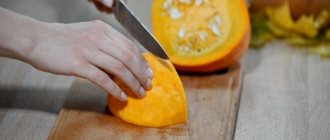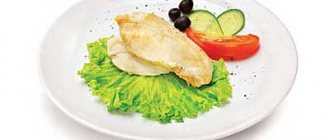What are the benefits of pulp?
The benefits of pumpkin for the body of every person are enormous, because this fruit is a real storehouse of useful substances, thanks to which it has valuable properties:
- Pumpkin fruit is good for the digestive system. Having a high fiber content, it greatly facilitates digestion.
- Improves vision. In order to have good vision for as long as possible, the body needs vitamin A, or, in other words, carotene. Despite the fact that its content in pumpkin is less than in carrots, the former is still beneficial for the human eye.
- Leader in the content of vitamin T, which is responsible for blood clotting. Due to the high content of this vitamin, pumpkin improves metabolism.
- Indispensable for people suffering from hypertension, as it has pectin fibers, which are indispensable in the fight against toxins, cholesterol and waste. Pumpkin juice helps normalize blood pressure and strengthen the walls of blood vessels. Used to prevent tuberculosis and pyelonephritis.
- Pumpkin preparations do not contain toxic substances, which allows them to be prescribed for the treatment of young children and the elderly, since they do not harm the body.
- Useful for people with kidney and bladder problems, as it has a mild diuretic effect.
- Helps fight insomnia.
- Useful for constipation and used as a laxative.
- Strengthens the body's protective functions.
- Has an anti-inflammatory effect. Used to eliminate the inflammatory process in the intestines. Also used externally, for example, for burns, eczema and wounds.
- Rejuvenates the body. This effect occurs due to the fact that pumpkin provokes tissue regeneration and faster cell renewal.
- Used for cosmetic purposes as part of masks.
Baked, raw, boiled pumpkin remains tasty and healthy in any form.
Use in dietetics and weight loss
Pumpkin is a very low-calorie product with a healthy composition. It can be safely consumed on a diet and under restrictive regimes. Even pumpkin pie will not be as high in calories as it seems at first glance due to the presence of dough there. In any case, nutritionists recommend this product for consumption, and you will find out why below. Here are some interesting facts about pumpkin!
- Pumpkin consists of almost 90% water, due to which it has incredible diuretic and choleretic properties.
- A huge number of carotenoids are contained in this product, and the brighter the color, the more there are.
- Pumpkins are stored for a very long time, and this is undoubtedly a big plus of the product. Under proper conditions, it can last a year without deteriorating at all!
- Pumpkin seeds are useful for men for potency and maintaining their libido in good shape. The same can be said about women's health, but for men their effect will still be predominant.
- In cooking, this product is indispensable and very versatile. You can cook anything with it, serving it as an appetizer, as a side dish, or as a main dish.
- It was with pumpkin that the first cream soups began to be made, and it still remains the best basis for this most delicate dish. And it has a lot of advantages: a simple recipe, cheap ingredients, and at the same time, tasty and healthy!
- It is not surprising that the product is popular among nutritionists, as the main recommendation for their patients, and among those losing weight, as a permanent guest in the refrigerator, because it contains a minimum of calories and maximum benefits, and at the same time, it is very easy to prepare. Moreover, only a few people don’t like this product, because it can be prepared in different ways, which means it can please more people.
Misconceptions
It all depends on the type of carbohydrates and how they are processed. Raw potatoes contain starch in a form in which we cannot digest it, and have a low GI, and boiled or fried - very high, more than 50. The same - carrots, raw and boiled - 30 and 80. Both - sweetish taste.
What does all this mean? Just about the fact that we, healthy people leading an active lifestyle... Oh, yes, I forgot that not everyone has decided to change their lives for the better. Okay, I'll say it differently. Everything can be learned by comparison, and if you check the GI of different “healthy and harmful” products, it will become clear that you can’t rely on whether it’s a fruit or a vegetable, or on taste or color. Judge for yourself:
The GI of sweet grapes is about 40, and that of green peas is 45;
- strawberries - 40, and everyone's favorite sprouted wheat grains - 60;
- muesli (those who want to lose weight love them so much) - 80, and cake with cream - 75 (not much difference, right?);
- the indicator for sweet raspberries is 30, and for completely unsweetened parsnips is 97;
- sweet apricots - 20, and red currants (a rather sour berry) - 30.
And so on.
And so on.
Healthy pumpkin dishes
Those who have already introduced pumpkin dishes into their diet appreciated the tasting and beneficial properties of the product. Pumpkin can be consumed either raw or cooked. Below are some simple recipes for pumpkin cooking options.
Recipes for making salads from raw vegetables
In order to add pumpkin to a salad, take ripe fruits with dense, edible pulp.
Salad with apple and pumpkin
- fresh pumpkin (400 g) is chopped on a coarse grater;
- 1 sour apple, peeled and seeds removed, cut into thin slices;
- After mixing the products, add finely chopped green onions;
- season with salt and sugar to taste.
Fill the ingredients with sour cream and serve the salad.
Apple-pumpkin salad with honey
- 600 g of firm ripe pumpkin pulp and 5 apples are grated;
- zest from 2 lemons and juice are added to the prepared mass;
- season with honey to taste and add ground walnuts.
You can also use hazelnuts or hazel.
Vegetable salad
- 200-250 g of fresh pumpkin, grated;
- tomatoes (3 pcs.) and bell peppers (2 pods) cut into cubes;
- a small onion is cut into thin rings;
- mix all the vegetables, adding crushed garlic (2-3 cloves) and herbs;
- salt to taste, sprinkle with vinegar (1 tsp) or lemon juice;
- season with olive oil.
Those who like it spicy can add a little ground black pepper or crushed capsicum to the salad. The dish can also be supplemented with pitted olives.
Baked Pumpkin Recipes
Pumpkins baked in the oven do not lose their healing properties, but acquire taste. The proposed recipes will be an excellent addition to the diet menu.
Pumpkin baked in the oven with honey
- fresh pumpkin (400 g) cut into small pieces;
- honey (2 tbsp) mixed with vegetable oil (1 tbsp);
- Roll the pumpkin in the prepared sauce and place it on a baking sheet.
Bake in a preheated oven for 40 minutes at 180 degrees.
Pumpkin in sour cream
You can bake pumpkin pieces in the oven without anything, and then serve with sour cream, or you can do it differently:
- salt the slices (0.5 kg) and roll in flour;
- fry in butter, place on a baking sheet;
- pour in whipped sour cream (150 g) and put in the oven.
This recipe can be varied by replacing the fermented milk product with sour cream sauce, adding eggs, spices and herbs.
Boiled pumpkin dishes
Pumpkin is added to first courses and delicious porridges are prepared from it, which children really like.
Rice porridge with pumpkin
- pumpkin (1 kg) is poured with water so that it lightly covers the chopped vegetable;
- salt to taste and, adding 200 g of rice, cook until the cereal is completely cooked;
- At the end of cooking, add butter (100 g).
If desired, water can be replaced with milk, and rice with millet or semolina. Porridge is served with sour cream, syrup or jam (as you like).
Sweet porridge
- heat milk (400 g) and add pumpkin cubes (300 g);
- add salt to taste, add sugar and bring to a boil;
- add millet (6 tbsp) and cook the porridge, adding butter (1 tbsp) at the end.
The sweet dish is served with fresh berries as a dessert for tea.
Cream soup
- pumpkin (0.5 kg) and carrots (3 pcs.) cut into cubes;
- vegetables are placed in a pan and poured with boiling water (1 l);
- add salt and sugar to taste and cook until the products soften;
- rub the soup through a sieve;
- grind flour (2 tbsp) in half a glass of water and add to the puree;
- adding tomato paste (2 tbsp), cook for a few more minutes.
Before removing from the stove, the puree soup is diluted with boiled milk (2 cups) until the consistency of sour cream. When serving, season with butter.
Soup with mushrooms and apples
- boil mushrooms (200 g) and simmer in vegetable oil along with parsley or celery root;
- 2 potatoes and pumpkin (200 g) cut into strips;
- Boil vegetables until half cooked;
- add mushrooms, tomato slices and sour apple;
- cook until fully cooked.
When serving the soup to the table, season with sour cream and sprinkle with green onions.
How many calories are in raw pumpkin?
Pumpkin consists of 90% water, so it is considered a dietary product. The small content of coarse dietary fiber and organic acids in the pulp makes it useful for inflammation of the stomach and intestines, and it can also be eaten for iron deficiency anemia and many other ailments. The calorie content of fresh pumpkin in its raw form is only 28 kcal per 100 g.
Read also: Cake made from old cookies
Let's take a closer look at the most popular varieties of pumpkin: butternut and nutmeg.
A pumpkin variety called butternut was artificially bred in 1960 in America by crossing wild African and nutmeg varieties. The key feature of butternut squash is the rapid ripening of the pumpkin - within 3 months from the moment of planting.
Butternut squash is very common in cooking because it has a pleasant nutty flavor and buttery texture. The product can be stored for a long time at room temperature, and it can be prepared in different ways: boiling, stewing, frying, baking, etc. The calorie content of butternut squash does not exceed 45 kcal per 100 g.
Butternut squash is a separate variety that is considered the most delicious of all. It was bred in Mexico, so the crop turned out to be heat-loving and long-ripening, unlike other varieties. In our country, nutmeg pumpkin is grown only in the southern regions.
The vegetable is distinguished by its elongated oblong shape and yellowish-brown color. The peel is quite thin and can be easily removed with a sharp knife. The pulp has a bright orange color and a pleasant nutmeg aroma. The calorie content of butternut squash is approximately 45 kcal per 100 g.
In cooking, this variety of pumpkin is used both raw and after heat treatment. It is suitable for preparing salads, stewed and fried dishes, used as a filling for pies and pancakes, etc.
Benefits of pumpkin for humans
Pumpkin is especially useful for the female body. A large amount of vitamin E has a beneficial effect on skin, nails and hair. Gynecologists recommend eating autumn vegetables to increase the chances of pregnancy, since vitamin E is involved in the formation of new healthy cells. But for those who have already experienced menopause, pumpkin will be a good antidepressant that will help get rid of unpleasant feelings during this period.
Pumpkin retains its beneficial properties after baking, boiling or steaming.
Not only the pulp of the pumpkin is edible, but also the seeds. They are high in magnesium, zinc and protein. But the energy value of the seeds is much greater than that of the pulp. 100 g of seeds contain 556 kcal, so they should be introduced into your diet carefully. For example, they make oil that can be added to salads; in this form, this product will be more beneficial.
The benefits of pumpkin for the human body are as follows:
- It has a diuretic effect (you remember that it is 90% water), which helps people who suffer from kidney problems. Raw pumpkin is recommended for use by people with kidney failure, as well as for the prevention of tuberculosis.
- Since pumpkin is a strong antioxidant, it is useful in preventing any pathogenic processes at the cellular level.
- For those who are obese or struggling with excess weight, pumpkin is a real godsend, as it helps digest foods faster.
- With constant consumption of pumpkin pulp, blood pressure normalizes. For people who play sports (active fat-burning workouts, which lead to increased blood pressure, are especially popular now), a few pieces of pulp will help normalize blood pressure levels.
- Although pumpkin does not have much vitamin A, it also has a beneficial effect on vision.
- Pumpkin is high in vitamin C, which supports the immune system. With the onset of autumn, try to eat vegetables as often as possible - you will get sick less.
Scientists have noticed that regular consumption of this autumn beauty normalizes sleep, so those who suffer from insomnia should definitely introduce pumpkin into their diet.
This melon crop has a good effect on the gastrointestinal tract (gastrointestinal tract). Therefore, people who suffer from constipation are recommended to make themselves a paste from fresh pumpkin. This treat is eaten for breakfast and better on an empty stomach.
You shouldn’t worry about stomach discomfort; there won’t be any, since pumpkin is easily and quickly digested (it doesn’t matter whether it has been heat-treated or not). Also, raw pumpkin will benefit those who have liver problems - only in this case it is better to eat it for lunch or dinner
Human health is a complex mechanism that needs to be carefully monitored, and pumpkin is an excellent assistant in this matter. If this vegetable is constantly in your diet, your well-being will improve, and your systems and organs will function without failure.
Since pumpkin is a gift of autumn, it does not grow all year round. But it can be prepared, for example, by freezing it in pieces or placing it whole in a cold and dark cellar. Pumpkin has excellent shelf life and the ability to be transported over long distances.
A little about the benefits and harmful qualities of the sunny vegetable
Why should you eat pumpkin often? It’s simple – it brings invaluable benefits to our health!
Benefits of pumpkin:
- lower cholesterol levels;
- will help the pancreas function;
- promotes wound healing;
- will help with atherosclerosis and nephritis;
- relieve coughing attacks;
- will prevent the development of cancer;
- awakens appetite;
- will support the heart;
- improve vision;
- will help with anemia.
On a note! Pumpkin seeds help in the treatment of helminthic infestations!
However, you should avoid pumpkin if you have been diagnosed with gastrointestinal diseases - gastritis, as well as ulcers. This vegetable is also harmful to everyone who suffers from diabetes and is prone to flatulence. And of course, those who are intolerant to its components should not eat pumpkin.
Attention! Pumpkin seeds are rich in salicylic acid, and it provokes a set of extra pounds and salt deposits. Excessive consumption of pumpkin seeds can cause nausea and even vomiting.
Benefits of pumpkin for body health
It’s not for nothing that pumpkin has earned so much attention; its beneficial properties allow it to be used as an effective remedy in the treatment of many diseases.
- Increases immunity and has an anti-inflammatory effect.
- Improves metabolic processes, cleanses the body of toxins, promotes weight loss.
- Treats heart disease, arrhythmia, coronary disease, atherosclerosis, anemia, and normalizes high blood pressure.
- Baked or boiled pumpkin, as well as its juice, has a diuretic, laxative and choleretic effect.
- The pulp of the fruit can cure stomach ulcers and duodenal diseases.
- Used as an effective remedy for tuberculosis, bronchitis, and bronchial asthma.
- The raw fruit is applied to boils and burns, and masks are made against skin rashes.
- Positively affects intestinal functions. Eliminates the appearance of constipation, useful for hemorrhoids. Recommended for problems with the genitourinary system. Helps prevent inflammation of the prostate gland and prostatitis.
- Pumpkin is an excellent remedy against blockage of blood vessels and helps remove excess cholesterol. It has a preventive effect against atherosclerosis and memory impairment.
- Thanks to its ability to remove excess fluid, the orange vegetable prevents the appearance of edema, and its low calorie content prevents the deposition of extra pounds.
- Recommended for the treatment of gout and osteochondrosis.
- Regular consumption of vegetables in any form has a positive effect on the nervous system. Improves sleep and restores activity. Equally useful for male and female bodies.
- Taking pumpkin is useful for people with diabetes mellitus, gastritis, colitis, enterocolitis, and dysbacteriosis.
- It is actively used for cosmetic purposes. For weakened hair and nails, against acne on the face, against dandruff and to moisturize lips.
- Pumpkin oil is no less precious product. Its spectrum of action is also wide, ranging from effects on the immune system to improving blood composition.
Benefits for various diseases
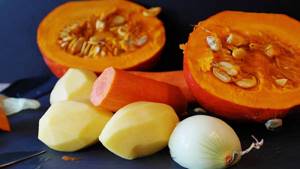
Boiled pumpkin is recommended to be included in the menu for the following diseases:
- gout;
- atherosclerosis;
- pathologies of the intestines, kidneys, liver, gall bladder;
- constipation;
- diabetes;
- obesity;
- skin lesions (dermatitis, eczema);
- diseases of the heart and blood vessels.
Harm
Although dietary fiber provides a number of benefits, it is best to eat the vegetable in moderation as there are some side effects of consuming too much fiber. Side effects of overeating:
May lead to weight gain. Although the vegetable is very healthy when it comes to weight loss, you should also remember that preserves, jams and jellies contain sugar and calories, which can lead to weight gain. If you want to enjoy pumpkin smoothies, make sure there is no sugar, otherwise your weight loss plan will go downhill. Pumpkin seeds provide numerous health benefits and are also a major contributor to weight gain. This is due to their high absorption capacity.
Harm to the digestive system. Some of the major side effects of overeating dietary fiber are malabsorption, abdominal pain, irregular heartbeat, indigestion, intestinal gas, and bloating. Therefore, it is better to eat pumpkin in moderation.
Moderate with diabetes. Although pumpkins are very effective in fighting diabetes, it is best to eat them in moderation as too much will lower your blood sugar levels to dangerously low levels, causing hypoglycemia.
Moderate when using medications. Also, if you are a diabetic patient and already taking medication, including too much of the vegetable in your diet may interfere with your treatment and may cause your blood sugar levels to drop - this is dangerous. If a person suffers from hypertension and is taking medication, then eating too much pumpkin along with the medication will cause hypotension. If you are taking medication, it is best to consume pumpkin in moderation and only as recommended by your doctor.
May cause hypotension. Although pumpkins are very effective in fighting high blood pressure, it is best to eat them in moderation because consuming too much can lower your blood pressure to dangerously low levels.
Excessive consumption of antioxidants. Although antioxidants provide many benefits, it is still best to eat them in moderation as there are some side effects of overdosing. At regular levels, antioxidants protect our cells from free radicals and reduce the risk of cancer. However, at higher levels, these antioxidants may even promote the development of cancer cells.
Use in moderation during pregnancy and lactation
Pregnant and nursing mothers should use pumpkin with caution. Pregnancy and the period of child care is a decisive step in the life of every woman.
It is necessary to eat food that is safe for the child’s health. It is better to consume pumpkin in moderation and only on the recommendation of a doctor. If you are taking any medications, discuss with your doctor and make sure that eating the vegetable will not interfere with your treatment.
Allergic reactions. The vegetable can cause allergic reactions such as itching, dermatitis, nasal congestion, difficulty breathing, shortness of breath, swelling of the lips and face. These people should avoid the vegetable completely, as even if pumpkin or seeds come into contact with the skin, an allergic reaction can occur.
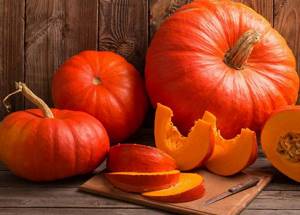
Beneficial features
Pumpkin truly has incredible healing properties due to its composition, namely:
- has a beneficial effect on the intestinal microflora;
- stimulates the functioning of the entire gastrointestinal tract;
- prevents the absorption of fat-containing components;
- regulates blood cholesterol levels;
- helps cure stomach ulcers;
- helps with diseases of the genitourinary system, as it acts as a good diuretic;
- helps with liver and kidney diseases;
- removes toxins and waste, cleanses the stomach and tones the body;
- fights tuberculosis;
- helps improve the condition of hepatitis and cirrhosis of the liver;
- helps with insomnia, relieves anxiety;
- useful for men with sexual dysfunction;
- strengthens the immune system;
- helps to lose weight;
- for women it has a beneficial effect on the cervix;
- can improve the condition of infertility, female inflammation, cervical erosion;
- useful for pregnant women;
- useful for women during menopause - improves the condition during this period.

Prevention of colds
Every morning you need to drink 200 milliliters of freshly squeezed pumpkin juice. This remedy improves immunity.
Treatment of toxicosis in pregnant women

Persistent nausea and toxicosis of pregnant women can be cured with pumpkin compote. It can be used without restrictions.
To improve the taste, honey and sugar are added.
Against helminths

300 grams of dried seeds should be crushed in a mortar or blender, pour 100 milligrams of honey into them. The mixture must be taken 2 tablespoons before meals for 7 days.
Pumpkin soup for weight loss
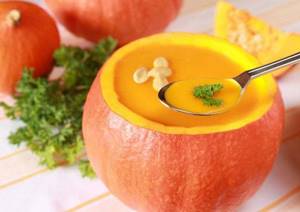
For a liter of water, take 1 kilogram of pumpkin pulp, 2 cloves of garlic, 1 onion, 50 grams of butter, 50 milliliters of milk, 2 tablespoons of vegetable or olive oil, 10 grams of sugar, pepper, salt to taste.
The pumpkin pulp and onion are cut into small cubes. The garlic is passed through the garlic press. The onion is poured into a pan, fried in butter until transparent, garlic and pumpkin cubes are added. Everything is fried for a few minutes. Water pours in. You need to cook over low heat for half an hour. Then everything is crushed in a blender, milk or cream, pepper, sugar, and salt are added.
For acne, burns, eczema
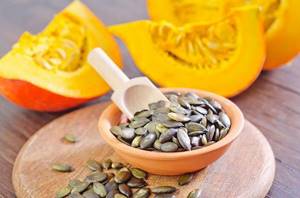
The pulp is grated and applied to the sore spot, pressed on top with a gauze bandage.
After an hour, it can be removed, and the remaining pulp is washed off with warm water.
Mask for dry and inflamed skin

A tablespoon of baked pumpkin puree is mixed with a tablespoon of cream or egg yolk. Apply to the face. Keep the mask on for 20 minutes. Then it is washed off and the face is blotted with a napkin.
Mask for sensitive skin
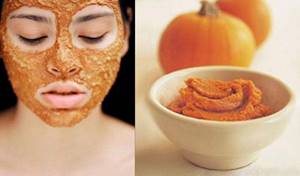
Take 40 milliliters of pumpkin juice, 50 grams of oatmeal, 1 egg yolk, a spoonful of honey. Pumpkin juice is mixed with oatmeal, egg yolk, and honey. The mixture is whipped with a mixer and applied to clean skin for 15 minutes, then washed off with warm water.
Any dish prepared from ripe pumpkin is beneficial. By adding various herbs, berries, fruits and vegetables to it, you can not only diversify your menu, but also enhance the beneficial qualities of the products.
Recipes
And now we come to the most delicious part of the material, namely the recipes! We've talked a lot about how you can cook anything with pumpkin, so now we want to share a few easy recipes based on it. Bon appetit!
Read also: Maxi black grapes variety description photo reviews
Pumpkin fried with honey
Ingredients:
| Pumpkin | 1/3 medium sized pumpkin |
| Honey | 2-3 tablespoons |
| Garlic | 1 clove |
| Butter | 25 grams |
| Sunflower oil | 1-2 tablespoons |
| Salt | taste |
| Pepper | taste |
| Rosemary | 1 sprig |
Cooking process
- Wash the pumpkin and cut into pieces no larger than 5-7 centimeters in diameter. Do not remove the crust.
- In a hot frying pan, fry them with butter and a crushed clove of garlic and a sprig of rosemary for 5-7 minutes.
- Then add honey and fry until it caramelizes. You can add a little salt and pepper at the end for some extra spice.

Pumpkin baked with cheese
Ingredients:
| Pumpkin | 1/3 medium sized pumpkin |
| Cheese | 100g |
| Garlic | 2 cloves |
| French mustard | 1 tablespoon |
| Salt | taste |
| Pepper | taste |
| Butter | 25-35 grams |
| Vegetable oil | 1-2 tablespoons |
- pumpkin;
- cheese (hard and mozzarella);
- garlic;
- French mustard;
- salt and pepper;
- butter or vegetable oil.
Cooking process
- Wash the pumpkin and remove the crust.
- Cut it into pieces and place in a deep plate or bowl.
- Add salt, pepper and oil there. Mix well.
- Place the resulting cubes in a baking dish, add chopped or squeezed garlic and French mustard on top and sprinkle with cheese.
- Place in the oven preheated to 180 degrees, bake at 120 degrees for 20 minutes.
- You can serve the dish garnished with herbs.

Pumpkin cream soup
Ingredients:
| Pumpkin | 1/2 pcs. |
| Potato | 2-3 pcs. |
| Carrot | 1 PC. |
| Onion | 1 PC. |
| Garlic | 2 cloves |
| Butter | 50 grams |
| Sunflower oil | 2 tablespoons |
| Salt | taste |
| Pepper | taste |
| Cream/sour cream | 1-4 tablespoons |
Cooking process
- Cut the pumpkin and potatoes into medium-thick cubes.
- Grate the carrots and cut the onion into small cubes.
- Preheat the pan by boiling water in advance.
- Add butter and sunflower oil to a heated pan, add onion and fry a little until golden brown.
- Then, as soon as the crust appears, add the carrots and fry for another 3 minutes, turning the heat down a little.
- After this, add potatoes and pumpkin, and pour boiling water so that the water just covers the filling a little (one or two fingers on top). 5 minutes before turning off the gas, add a few cloves of garlic, crushed with a knife.
- Cook the resulting mixture until the products are completely cooked (let them be boiled).
- Remove from heat, add salt and pepper to taste, and beat the resulting mass with a blender.
- Gradually add cream to taste (if you don’t want cream, add sour cream to the dish already poured into plates).
- Serve with croutons or toasted bread.
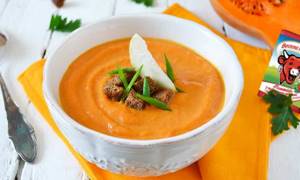
Boiled pumpkin
Pumpkin is a valuable melon crop with a rich chemical composition. It is very easy to prepare at home. Boiled pulp makes excellent porridges, soups, and purees for baby food. The advantage of this method of culinary processing is the preservation of the beneficial qualities inherent in the raw vegetable.
Benefits and harms
Pumpkin contains a lot of useful elements that have a beneficial effect on all systems of the human body.
Vitamin T, which is found in large quantities in pumpkin, helps digest meat, legumes, and vegetables with a high content of coarse fiber.
Copper, iron, calcium, cobalt and zinc increase hemoglobin, strengthen bones, and strengthen the immune system.
Fiber accelerates the elimination of toxins and cholesterol and helps reduce excess weight.
Boiled pumpkin is suitable for baby food from an early age
The bright orange shade attracts the attention of little ones. Mashed potatoes, cereals and soups are often liked by picky little ones
They perfectly saturate and replenish vitamins and minerals.
Boiled pulp helps pregnant women fight edema. This is facilitated by potassium, which gently and safely removes excess fluid from tissues.
Boiled pumpkin masks can replace many expensive cosmetic products. They fill the skin with moisture, nourish, vitaminize and smooth out the network of fine wrinkles.
In addition to its beneficial effects on the body, boiled pumpkin can harm people suffering from:
- diabetes mellitus (the pulp contains a lot of sucrose and fructose, which lead to sharp jumps in insulin);
- ulcerative lesions of the gastrointestinal tract in the acute stage;
- chronic diarrhea (pumpkin has a laxative effect).
Reference. The ban on pumpkin for stomach ulcers applies more to the raw vegetable. Boiled pulp is allowed to be consumed in small quantities.
Compound

The pulp of boiled pumpkin contains almost the same nutrients as the raw vegetable:
- vitamin A - useful for myopia, supports healthy teeth, skin, nails and hair;
- B vitamins - normalize sugar levels, strengthen the immune system, increase resistance to stress, improve the functioning of the digestive tract;
- vitamin D - forms and strengthens bones, inhibits the development of cancer cells, invigorates;
- vitamin K - prevents the leaching of minerals from bones;
- vitamin PP - normalizes the state of the nervous system;
- Vitamin T - helps digest food;
- iron - increases hemoglobin;
- magnesium - regulates the functioning of the heart muscle;
- cobalt - responsible for hematopoiesis;
- zinc - rejuvenates, relieves inflammation of the prostate gland, relieves sexual dysfunction;
- copper - helps the body absorb iron.
KBJU and glycemic index
Nutrients:
- proteins – 1 g;
- fats – 1 g;
- carbohydrates – 4.4 g.
How many calories are in boiled pumpkin? Per 100 g of pulp - only 28 kcal.
Glycemic index of boiled pulp is 75 units. This is a fairly high figure, so diabetics are advised to consume pumpkin in limited quantities. For them, the beneficial effect of pumpkin on the pancreas is especially noteworthy.
Reference. The glycemic index (GI) is an indicator that displays the rate at which blood sugar levels increase when specific foods are consumed. The body absorbs fast carbohydrates quickly. The jumping glucose level signals the pancreas to produce a portion of insulin.
Chemical composition
It doesn’t matter at all how many calories there will be in boiled pumpkin in water, because the main thing is what components are included in this product. The fact is that regardless of the calorie content and type of product (boiled or baked pumpkin), the beneficial substances in it remain the same.
Of course, their percentage changes approximately, but the essence remains - this is truly a very good product that incorporates everything that is most necessary for the human body. Includes:
- beta-carotene;
- vitamin C;
- B vitamins (B1, B2, B3, B9);
- vitamin T (very rare);
- copper;
- potassium;
- phosphorus;
- iron;
- magnesium;
- silicon;
- cobalt;
- calcium;
- iodine;
- fluorine;
- zinc.
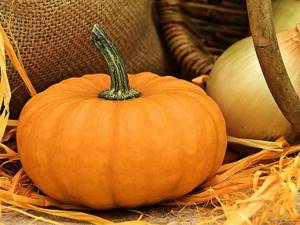
How to prepare pumpkin for healthy cooking
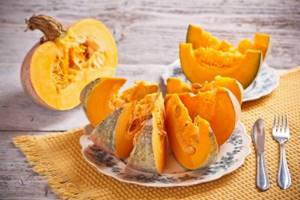
- Choose a medium-sized vegetable (maximum 5 kg).
- Be sure to wash thoroughly.
- Make several cuts on the peel.
- Place in the oven for a few minutes
- After this, the peel will become soft and you can easily cut it off with a knife.
In raw form, you can eat no more than 30 g per day. This helps improve the digestion process. The benefits of baked pumpkin lie in its nutritional value and low calorie content. You can cook it even during a diet, and not be afraid for your figure.
The benefits of boiled pumpkin cannot be overestimated. Porridge will be a healthy and nutritious breakfast for everyone who cares about their figure and adheres to a healthy lifestyle. It contains a large amount of fiber, which helps normal intestinal function.
And, of course, how can you ignore pumpkin desserts? Jam with nuts will become a favorite treat for the whole family on cold, winter evenings. Here is the simplest recipe:
- Peel the pulp and remove seeds.
- Cut into equal medium-sized pieces.
- Cook sugar syrup in advance (1 kg of sugar for 1-2 glasses of water)
- Pour the pumpkin pieces with sweet syrup and stir.
- You need to cook for 7-10 minutes. You should constantly stir and monitor the foam.
- Remove from heat, cool and add a glass of chopped nuts.
Then cover tightly and store in a cool, dark place. Children can be pleased with sweet slices baked in the oven. Once cooked, they are sprinkled with powdered sugar on top.
There are also rules when drying seeds.
- They should be thoroughly cleaned of pulp and fibers. Otherwise they will begin to rot.
- Dry them a little on a tray. In order for them to be easily cleaned, 3 hours is enough.
- Then spread in an even layer on a baking sheet and place in the oven.
- Cooking time: 25 minutes at 180°C.
- To prevent them from burning, you need to turn them over.
And finally
Interestingly, the flowers of the plant can also be used as food. They can be stuffed or cooked in batter. Use “male” flowers for food, that is, those that do not bear fruit. As a result, you will get an unusual snack that will please any gourmet.
Baked or boiled pumpkin - the benefits and harms depend on the state of health and individual reaction. If you have gastrointestinal disorders, it is better to avoid such dishes.
The “golden” vegetable is considered a storehouse of valuable vitamins. Regular use of the pulp, seeds or flowers will be a wonderful source of natural antioxidants and immunostimulants for your health.
However, the benefits and harms of pumpkin for the human body are determined by a reasonable approach. It is recommended not to purchase large vegetables, as they are considered fodder crops. It is better to give preference to the type and variety that is grown in your region. To determine the correct choice, you can try a piece when purchasing.
How to cook and how to use

You can cook boiled pumpkin in a saucepan, double boiler, slow cooker, or microwave.
To make the vegetable tasty and retain maximum nutrients, use our tips:
- Wash the fruit with warm water, cut into pieces, remove the bark and remove the fibrous core with seeds. Do not throw away the seeds, but dry them. They contain no less useful substances than the pulp.
- Cut the pulp into pieces and cook in plain water, milk or mix them in equal proportions.
- To maintain its shape, generously brush with butter.
- Salt and bring the water to a boil before adding the pulp. In cold water, the pumpkin takes longer to cook and becomes very soft.
- The ratio of liquid to vegetable is 2:1, otherwise the product will cook unevenly.
- Check doneness with a fork or knife. If the flesh is easily pierced, it is ready.
- At the end of cooking, place the pumpkin in a colander. Do not leave in water under any circumstances if you want to preserve the vitamins and shape of the pieces.
- Add a little vegetable oil to the water. This will help the flesh cook evenly.
- Cook the pumpkin covered and over medium heat.
- In a multicooker you can cook in the “Steam” or “Soup” mode. Maximum cooking time is 30 minutes.
- To prepare pumpkin for desserts, add sugar instead of salt, cinnamon, vanilla, and star anise to the water.
Cooking time:
- in a saucepan - 30 minutes;
- in a slow cooker – 35 minutes;
- in a double boiler – 30 minutes;
- in the microwave - in two stages of 10 minutes each;
- in a pressure cooker - 25 minutes.
Important ! For children, boil the pumpkin until completely softened.
Norm per day
The norm for boiled pumpkin consumption for healthy people is 500 g.
The norm for diabetics is 200-300 g per day, which must be divided into small portions.
Pumpkin oil
It’s not just the pulp that has excellent beneficial properties. Large seeds are a source of oil. It is very popular in folk medicine and is widely used by cosmetologists.
The benefits are quite noticeable if you include pumpkin oil in your diet. And harm, it is worth noting, can also occur. Let's look at the benefits.
Skin diseases. The oil has antiseptic and wound-healing properties. Its anti-inflammatory effects are known. For many skin diseases it is included in complex therapy. It perfectly promotes the treatment of trophic ulcers, burns, herpes, various wounds, bedsores, cracked lips.
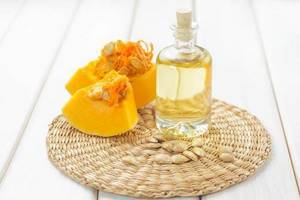
- Immunity. Regular consumption increases the human body’s resistance to various bacterial, infectious, and viral diseases. The oil significantly strengthens the immune system.
- Nervous system. The most valuable source of potassium, magnesium, and B vitamins allows you to get rid of insomnia and headaches. A positive effect has been noticed in cases of nervous disorders.
- We should not forget that no matter how good pumpkin oil is, there are benefits and harms in it. In what cases can its use lead to trouble?
Flaws:
For some people, the use of pumpkin oil can provoke rather unpleasant symptoms - frequent bowel movements, painful belching. There are cases, although quite rare, where the product has caused allergic reactions. People suffering from calculous cholecystitis should take the oil with great caution. After all, it can very easily provoke the movement of stones. Before treatment with pumpkin oil, you should definitely consult a doctor
He will choose the right dosage. You should not abuse the product so that instead of the long-awaited benefits, it does not cause harm to the body.
Before treatment with pumpkin oil, you should definitely consult a doctor. He will choose the right dosage. You should not abuse the product so that instead of the long-awaited benefits, it does not cause harm to the body.
A healing gift for autumn
As if taking care of our health, before a long winter, deprived of fresh vitamins from the garden, nature presents us with a bright sunny gift - pumpkin. It is not for nothing that this vegetable has the property of long-term storage. Such a massive vitamin reserve should definitely take its rightful place in the pantry of every skillful housewife.
In the kitchen, pumpkin will reveal all its secret beneficial properties and give away vitamin riches to everyone who tastes delicious dishes. The magazine "Chasnosti.Com" is confident that pumpkin will become an indispensable vegetable friend for those who care about a properly balanced and healthy diet. In addition to all the qualities already mentioned, this autumn fruit also has healing characteristics: it helps to cure diseases and improve the general condition of the body.
Pumpkin jam
Pumpkin jam attracts with its beautiful amber color, intriguing taste and piquant aroma, which provides the presence of all kinds of spices. This dessert will diversify your diet, fill it with vitamins and other substances important for the body. In addition, with the help of pumpkin jam, this melon can be put to good use during the big harvest season. This delicacy will surely become the most favorite pumpkin dish, which, thanks to many interesting additives, will appeal to all its tasters.

Pumpkin and zucchini jam
Ingredients:
950 g pumpkin, 950 g zucchini, 1700 g sugar, 145 g lemon, 140 g raisins, 180 g dried apricots, 370 ml water.
Preparation:
- We wash the dried fruits.
- Add boiling water and leave them in for 15 minutes.
- Wash the vegetables and remove the skin.
- We extract the seeds from the pumpkin.
- We weigh the peeled vegetables - their mass should be equal to the weight of sugar or a little more if the pumpkin is very sweet.
- Remove the yellow part of the zest from a well-washed citrus. Grate it.
- We clean the lemon from white veins and seeds.
- Grind the pumpkin, zucchini, dried apricots, and lemon in a meat grinder.
- Sprinkle raisins, sugar, chopped zest into the mixture. Stir.
- Warm up slowly, stirring constantly. Boil for 30-50 minutes until thickened. In the process, remove the foam and stir so that the dish does not burn.
- Pour the pumpkin-squash jam into clean, warm jars.
- Let's roll up.
- Place the lids down. Turn over after 15 minutes.
Pumpkin and apple jam
Ingredients:
470 g pumpkin, 310 g sour apples, 440 g sugar, 4 g cinnamon, 580 g water, 120 g walnuts.
Preparation:
- Wash pumpkin and apples.
- We clear them of seeds.
- Cut out the fibrous part of the pumpkin pulp where the seeds are located and remove the peel.
- We cut the prepared products into cubes.
- Cut the peeled nuts into pieces of arbitrary shape.
- Fry without oil for about 7 minutes, stirring occasionally.
- Pour water into the pan and place the pumpkin pieces. With constant heating and stirring, add sugar.
- After boiling, add apples. Boil for half an hour, skimming off the foam.
- Add nuts to the jam and add cinnamon. Boil slowly, stirring, for 20 minutes. Transfer to clean, dried jars.
- Place parchment paper on top, cut to the size of the neck diameter. Store in the cold.
Pumpkin jam with cherry plum
Ingredients:
1070 g pumpkin, 1070 g cherry plum, 1100 g sugar, 180 ml water.
Preparation:
- Wash the pumpkin and cherry plum.
- Cut the skin off the pumpkin and remove the seeds.
- Cut the pulp into cubes.
- We peel the cherry plum from the pits.
- We boil water. Blanch the pumpkin for 10 minutes. Add cherry plum and keep on heating for another 6 minutes.
- Grind the softened ingredients with the broth in a blender or pass through a sieve. While heating slowly, add sugar.
- Stirring constantly, boil for a couple of minutes.
- Pour into sterile, dried jars.
- We seal it hermetically.
- Cool slowly, wrapping it in a blanket and turning it upside down.
Pumpkin jam with orange and lemon
Ingredients:
- Pumpkin – 1 kg
- Lemon - 0.5 pcs.
- Orange - 1 pc.
- Sugar - 800 g
Preparation:
- Cut the pumpkin into cubes, after first cutting off the peel and inner pulp with seeds.
- Sprinkle the prepared pumpkin cubes with granulated sugar.
- Place the container on the fire to simmer. Cook the pumpkin in three batches for 15 minutes. That is, bring to a boil, boil for 15 minutes, let cool, and then boil again and cool.
- After the third stage of cooking, add pieces of chopped lemon and orange to the softened pumpkin. Return to heat and cook for another 10 minutes.
- Place in sterilized jars and seal with lids. Turn the jars over and cover with a blanket until completely cool.
Pumpkin. Benefit and harm. Pumpkin dishes – ZDRAVBUD.NET
Calorie content of pumpkin, BZHU and GI
Pumpkin is not always consumed as a separate dish, so it is important to consider the caloric content of each ingredient
| Types of pumpkin dishes | Calorie content (per 100 g) |
| In its purest form | 25 |
| Baked pumpkin | 45 |
| Boiled pumpkin | 38 |
| Pumpkin with milk | 200 |
| Pumpkin with sugar: · baked; · boiled; · stewed. | 130 128 160 |
| Glycemic index | 75 units |
Pumpkin BJUs are indicated taking into account the % of a person’s daily dose of the substance.
| Substance | Quantity, g (per 100 g of product) | % of daily requirement |
| Squirrels | 1,1 | 2,3 |
| Fats | 0,1 | 0,2 |
| Carbohydrates | 4,4 | 1,7 |
This is a carbohydrate product that provides the body with a lot of energy, but it is not enough to cover the daily dose of other products. If it's grains and energy, it's better to eat pumpkin in the morning as a balanced breakfast - carbohydrates and proteins.
Chemical composition of pumpkin - what vitamins are present in it?
If we consider pumpkin as a chemical product, then in the laboratory they will produce a number of components and vitamins that it possesses:
- alimentary fiber;
- phosphorus;
- sulfur;
- chlorine;
- magnesium;
- ascorbic acid;
- potassium and calcium;
- fluorine.
We can talk about pumpkin for a long time, since the list of even the smallest components in terms of significance and content is endless. It contains the finest compounds that are included in the composition of adsorbents, but they do not appear as completely as is usually observed in practice, for example, among activated carbon. Overall, this is a good set of vitamins that can be obtained even by people with gastrointestinal diseases, despite the high fiber content. The main thing is to properly process the dish so that it is not only tasty, but also healthy.
Calorie content of the product
The calorie content of raw pumpkin per 100 grams is 28 calories. Quite a small volume, given that a person is unlikely to eat more than 200-300 grams per day, this product can be considered dietary. But few people consume pumpkin raw, so we will give a more realistic example, namely, the calorie content of baked pumpkin per 100 grams is 46 grams.
Not so much, but still more than in its raw form. With this example I would like to show that it is always important to check not how many calories fit in a raw product, but how many of them are in the product that you use in life. Agree, when you see the calorie content of 300 grams on a package of porridge, you will think that this is too much and will not take it, but in fact, many cereals and porridges evaporate when cooked and can contain less calories than in dry form.
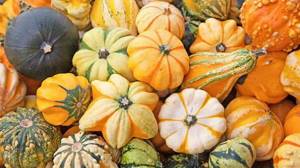
It is for this reason that we suggest that you familiarize yourself with the list below in detail in order to understand how many calories are in pumpkin if it is not just raw, but cooked in different ways. If we talk about the dosage in which pumpkin should be consumed, and what amount of calories is considered normal per day – 500-600 grams.
This volume will contain enough useful components to give the body everything it needs for adequate functioning, and it will also contain enough calories so as not to overeat and not see the number on the scale increase. However, it all depends on the form in which you eat the pumpkin. We'll talk about this below.








